Asterope, 21 Tauri (21 Tau), is a blue-white main sequence star located in the constellation Taurus. It is one of the brightest stars in the Pleiades cluster (Messier 45), one of the brightest and nearest open clusters to Earth. Asterope lies at a distance of 431 light years from Earth and has an apparent magnitude of 5.76. In exceptionally good conditions, it is visible without binoculars.
Star type
Asterope is a main sequence star with the stellar classification B8 V. It has a mass 2.93 times that of the Sun. With an effective temperature of 11,041 K, it is about 100 times more luminous than the Sun. The star is a very fast spinner, with a projected rotational velocity of 159 km/s. It shows excess emissions in the infrared due to a reflection nebula that surrounds it.
The star is part of a double star system sometimes referred to as Sterope I and Sterope II. The two stars, 21 Tauri and 22 Tauri, both belong to the Pleiades cluster. They are separated by 2.82 arcminutes and appear as a single elongated star of magnitude 5.6 to the unaided eye.
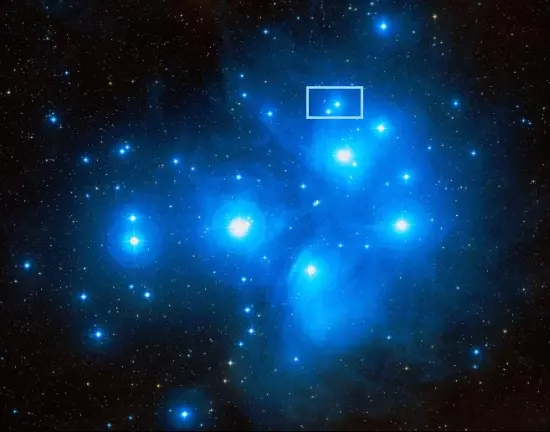
Asterope (21 Tauri), image: Wikisky
22 Tauri is a white main sequence star of the spectral type A0 Vn. It has a radius 3.1 times that of the Sun and is 6.36 times more luminous. It is slightly hotter than 21 Tauri, with a temperature of 11,817 K. It spins even faster than its neighbour, with a projected rotational velocity of 232 km/s. It has an apparent magnitude of 6.43, which puts it near the lower limit for unaided eye visibility.
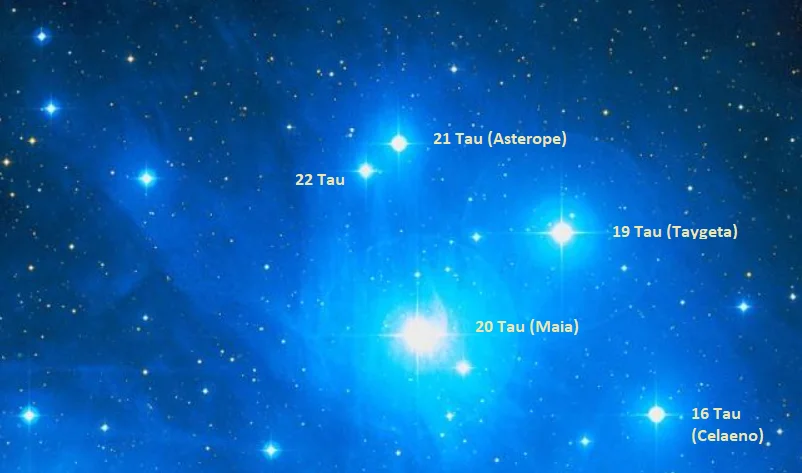
Sterope I and Sterope II, image: Wikisky
Pleiades
Asterope is one of the brightest stars of the Pleiades cluster, also known as Messier 45 (M45), a large open cluster with an apparent magnitude of 1.6. At a distance of about 444 light years, M45 is one of the nearest clusters to Earth. It is also one of the brightest, with up to 14 of its brightest stars visible without binoculars in ideal conditions. Most observers, however, can normally spot about six to eight stars without binoculars.
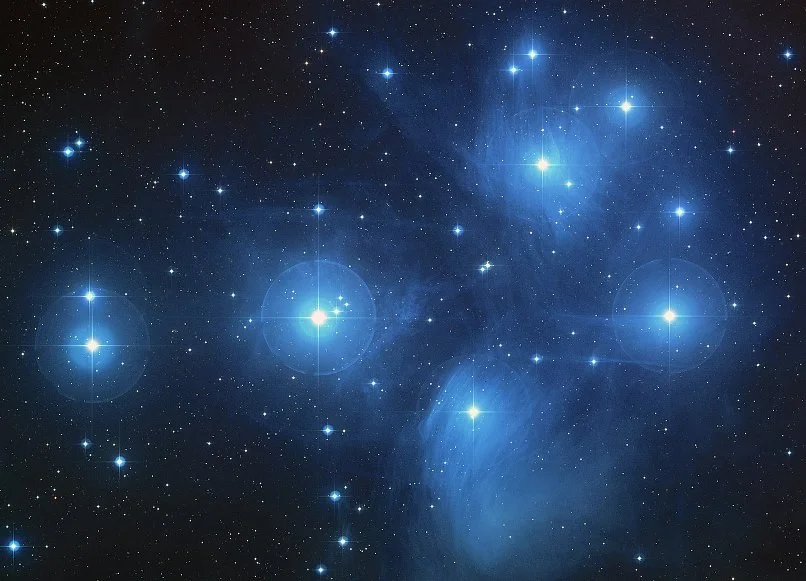
The Pleiades (M45), image: NASA, ESA, AURA/Caltech, Palomar Observatory, credit: D. Soderblom and E. Nelan (STScI), F. Benedict and B. Arthur (U. Texas), and B. Jones (Lick Obs.)
The cluster contains over 1,000 known members and has a total mass of 800 Suns. The brightest members are hot class B stars that formed within the last 100 million years. M45 occupies an area of 110 arcminutes and is one of the most prominent features of the night sky from October to April.
The Pleiades stars were formed in the same molecular cloud and are moving together through space. They will continue to do so for another 250 million years, after which the cluster will slowly disperse due to interactions with the interstellar neighbourhood.
The nine brightest stars in M45 are named after the Seven Sisters in Greek mythology – Alcyone (Eta Tauri), Asterope (21 Tauri), Celaeno (16 Tauri), Electra (17 Tauri), Maia (20 Tauri), Merope (23 Tauri) and Taygeta (19 Tauri) – and their parents Atlas (27 Tauri) and Pleione (28 Tauri). The brightest member of the cluster, the magnitude 2.87 giant Alcyone, is the third brightest star in Taurus constellation, after Aldebaran and Elnath.
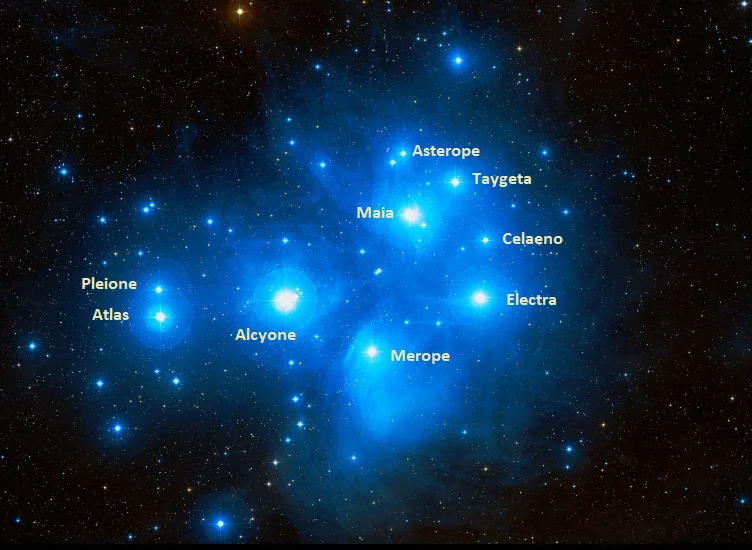
The Pleiades, image: Wikisky
In Greek mythology, the Titan Atlas was condemned to carry the heavens on his shoulders after the Titans had lost the war against the Olympian gods. His seven daughters, the Pleiades, caught the eye of Orion, the hunter, who began to pursue them. Zeus transformed the Pleiades into doves and then placed them in the sky as stars, where they still appear to be pursued by the constellation Orion.
Facts
The Pleiades have been known since ancient times and played a significant role in navigation across many different cultures. They were mentioned in the Bible, Homer’s Iliad and Odyssey, and Hesiod’s Works and Days, among other ancient texts.
The earliest known depiction of the cluster was discovered on the Nebra sky disk, a Bronze Age artifact uncovered in Germany, dating back to 1600 BCE.
In Japan, the Pleiades were known as Mutsuraboshi and mentioned by this name in the 8th century Kojiki (“An Account of Ancient Matters”). Today, the cluster is known as Subaru. The car company Subaru uses an image of the six brightest members in its logo.
Italian astronomer and physicist Galileo Galilei was the first to observe M45 in a telescope. He found that the cluster contained many fainter stars invisible to the unaided eye. Galilei published his notes and a sketch of the cluster in March 1610.
In 1786, French astronomer Edme-Sébastien Jeaurat published a map of 64 stars in the cluster.
Name
The name Asterope (pronunciation: /əˈstɛrəpiː/) comes from Greek mythology. Asterope (or Sterope) was one of the Pleiades, the seven daughters of the Titan Atlas and the nymph Pleione. Depending on the source, she was either the wife of King Oenomaus of Pisa or his mother by the god Ares. The name Asterope (Greek: Ἀστερόπη) or Sterope (Greek: Στερόπη) comes from the word στεροπή (steropē), meaning “lightning.”
The name was officially approved by the International Astronomical Union’s (IAU) Working Group on Star Names (WGSN) on August 21, 2016. It formally applies only to the component 21 Tauri A.
The Chinese know Asterope as the Third Star of Hairy Head. Hairy Head is an asterism formed by the Pleiades stars Asterope, Atlas, Electra, Maia, Merope, Taygeta, and Alcyone. It is one of the seven mansions of the White Tiger.
Location
Asterope is relatively easy to find because it is a member of the Pleiades cluster. M45 is one of the most recognizable features of the night sky and easily spotted on its own. It can be found along the imaginary line extended from Orion’s Belt stars – Alnitak, Alnilam and Mintaka – past Aldebaran and the Hyades cluster, which outlines the head of the celestial Bull.
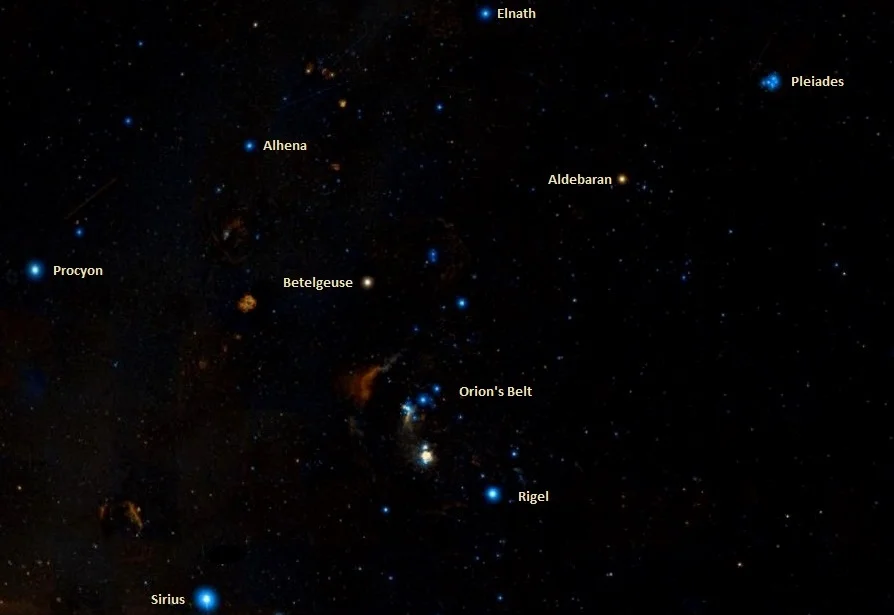
Pleiades location, image: Wikisky
M45 is prominent in the sky from October to April. It cannot be seen in May and June, when it is too close to the Sun.
Constellation
Asterope is located in Taurus, one of the oldest constellations in the sky. It was first listed by the Greco-Roman astronomer Ptolemy in the 2nd century CE, along with other zodiac constellations. Taurus is the 17th largest of the 88 constellations, occupying an area of 797 square degrees.
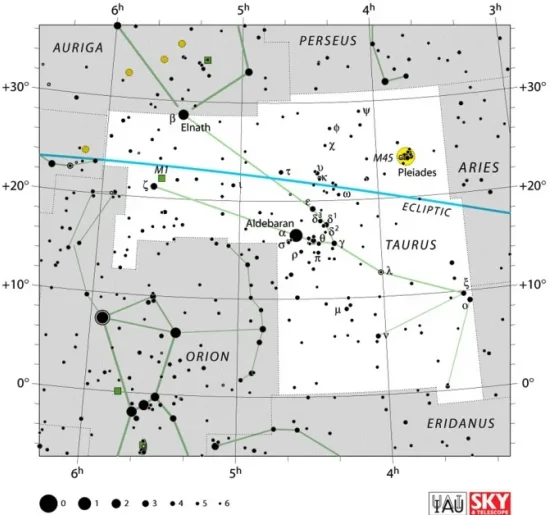
Taurus constellation map by IAU and Sky&Telescope magazine
The constellation is best known for its two bright, large open clusters – the Pleiades and the Hyades – as well for the orange giant Aldebaran, the 14th brightest star in the sky. It is also home to the Crab Nebula (Messier 1), the remnant of a historic supernova, the supernova remnant known as the Spaghetti Nebula (Sh2-240), the planetary nebula known as the Crystal Ball Nebula (NGC 1514), and the reflection nebula NGC 1555 (Hind’s Variable Nebula), whose brightness varies because it is illuminated by the light of the variable star T Tauri.
The best time of year to observe the stars and deep sky objects in the constellation is during the month of January.
The 10 brightest stars in Taurus are Aldebaran (Alpha Tau, mag. 0.86), Elnath (Beta Tau, mag. 1.65), Alcyone (Eta Tau, mag. 2.87), Tianguan (Zeta Tau, mag. 2.97), Chamukuy (Theta2 Tauri, mag. 3.40), Lambda Tauri (mag. 3.47), Ain (Epsilon Tau, mag. 3.53), Omicron Tauri (mag. 3.61), Atlas (27 Tau, mag. 3.63), and Prima Hyadum (Gamma Tau, mag. 3.654).
Asterope – 21 Tauri
| Spectral class | B8 V |
| B-V colour index | +0.04 |
| Apparent magnitude | 5.76 |
| Absolute magnitude | +0.34 |
| Distance | 431 ± 8 light years (132 ± 2 parsecs) |
| Parallax | 7.5658 ± 0.1321 mas |
| Radial velocity | +6.0 ± 0.6 km/s |
| Proper motion | RA: +20.025 mas/yr |
| Dec.: −45.949 mas/yr | |
| Mass | 2.93 ± 0.07 M☉ |
| Luminosity | 100 L☉ (87-115 L☉) |
| Temperature | 11,041 ± 76 K |
| Age | 100 million years |
| Rotational velocity | 159 km/s |
| Surface gravity | 4.250 ± 0.113 cgs |
| Constellation | Taurus |
| Right ascension | 03h 45m 54.47676s |
| Declination | +24° 33′ 16.2418″ |
| Designations | Asterope, 21 Tauri, HD 23432, HR 1151, HIP 17579, GC 4502, GCRV 2100, SAO 76159, BD+24° 553, PPM 92844, IRAS 03429+2423, 2MASS J03455447+2433162, AAVSO 0339+24, WDS J03459+2433A, TYC 1803-1584-1, Gaia DR1 66798492484311936, Gaia DR2 66798496781121792 |